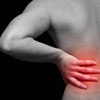A back just doesn’t get appreciated until it plays up. So, sit up and take note of these spine statistics:
- 80% of the population will experience back pain at some time
- 60% of non-specific back pain is resolved without medical intervention
- 25 – 40% of people with back pain seek healthcare and rehabilitation
- 60 – 75% of back pain sufferers have recurrences
- Worldwide, back pain costs economies more than any other disease
- In Europe, 10 – 15% of all sick days are taken due to lower back pain
- It is estimated that 60% of people complain about back problems after going on a long car journey
- Back pain is the leading cause of disability for workers between the ages of 19 and 45
Get to know your spine
The spine is, as you know, that flexible bone column that extends from the base of your skull to your tailbone. It consists of 33 vertebrae.
There are cartilaginous cushions between the vertebrae, called intervertebral discs, that act as shock absorbers.
Facet joints are between the vertebrae and guide spinal movement.
What causes spinal pain?
- Poor posture and inactivity
- Prolonged exposure to sitting and poor workstation set-up
- Increased body weight, especially around the abdomen
- Stress and anxiety
- Degeneration due to old age, trauma and overload, inadequate ‘core stability’ support
How to avoid spinal pain
- Develop good posture, keep an ideal body weight and minimise stress
- Stay active, fit and flexible. Stretching - something we do instinctively even as babies - is vital.
- Ensure good ‘core stability’ through exercises. Pilates, isometrics, yoga, and similar disciplines are specifically geared at stretching and developing core strength
- Avoid long periods of sitting - stand up and walk around; and ensure ergonomically sound workstation set-up
- Lift carefully and correctly.Alexander technique is worth exploring if you're having problems, or obtain advice from a physiotherapist or chiropractor
- If you have back pain, see a physiotherapist
What can go wrong?
Arthritis: Inflammation of a joint characterised by swelling, pain and restriction of movement. It is usually referred to as osteoarthritis in the spine. It is also known as spondylosis.
Disc degeneration: A change in structural and functional integrity of the disc.
Lumbago: Non-medical term signifying pain in the lower back.
Osteoporosis: A disorder in which bone is abnormally brittle.
Sciatica: Pain along the course of the sciatica nerve in the back of the thigh and below the knee. This can be caused by irritation of a nerve found anywhere from the back of the thigh.
Slipped disc: Partial or complete displacement of the gel-like tissue inside the disc, due to disruption of the outer fibrous tissue. Also known as slipped disc, ruptured disc or herniated disc.
Spinal stenosis: The narrowing of the spine, commonly caused by degenerative changes in the discs or joints.
Whiplash: Injury caused by rapid and uncontrolled movement of the neck caused by an external force like in a car accident or other incident.- (Source: The South African Society of Physiotherapy)




 Publications
Publications
 Partners
Partners











